Water pumps for home plumbing play the most important role. They can be compared to the human heart.
It is only thanks to the presence of a pump in the system that it is possible to ensure a constant and uninterrupted circulation of the liquid as we need it. Maintaining a normal level of pressure in the pipelines is also the task of the pump.
Features and types of equipment
A water pump is a must have. Without it, it is impossible to pump water into the pipeline and keep it there. long time. Moreover, the pump performs both the role of the main initiator of the action and the function of a boosting station.
If the water pressure in the pipes is too weak, then it is with the help of a pump that it can be leveled to acceptable values. The presence of automation allows you to forget about the constant monitoring of the work of the water supply.
The water supply booster pump will be controlled by electronic or mechanical relays. From a person it is only required to install it correctly, configure it and put it into operation.
Here are some of the main types of pumps that are most often used in the device household systems water supply.
- The submersible water pump for the water supply is located directly in the well. From there, it pumps liquid into the suction pipe and transfers it to the main water supply. Submersible pumps are difficult to install, but they are very productive and have an optimal price;
- Semi-submersible pumps differ from submersible ones only in that their design does not provide for the possibility of submerging the pump motor under water. Therefore, semi-submersible models have a special design using floats. The characteristics of such equipment are inferior to their submersible counterparts;
- The pumping station for the water supply system consists of a surface pump and a hydraulic accumulator. The presence of a storage tank is a real necessity, since the power of surface units is often not enough to maintain a normal level of pressure in the pipes;
- The circulation pump for water supply is also called booster. It should be understood that almost any pump somehow raises the pressure in the system, which allows all of them to be attributed to this category of equipment. However, it is the circulation pump that increases the pressure in the water supply system that focuses solely on performing this function. Circulation pumps do not serve the suction sections of the pipeline. They only increase the pressure in the pipes if the initial power of the base pump is not enough for this.
It is necessary to select a conventional or booster pump for water supply according to several main characteristics and indicators.
First you need to evaluate the type of pump. Submersible pump for the pipeline is ideally suited to work with wells. Semi-submersible systems work better with wide wells.
Pumping stations are equipped with basic relays and hydraulic accumulators, which gives them an advantage over those who want to quickly assemble the water supply and put it into operation.
Only in any situation, it should be remembered that surface-type pumping stations cannot effectively service wells or wells with water, which is below 10 meters.
Circulation pumps are used in systems of any type. The operation of the pump on the pipeline consists in increasing the nominal pressure in the pipes and facilitating the circulation of liquids through the heating circuits.
Based on these properties, the circulation pump is widely used not only in domestic, but also in heating pipelines. For example, to promote fluid circulation through underfloor heating systems.
If someone selects a pump for water supply in an apartment, then in 95% of cases he means exactly the booster circulation pump.
Calculate first required power head. To do this, use the following formula.
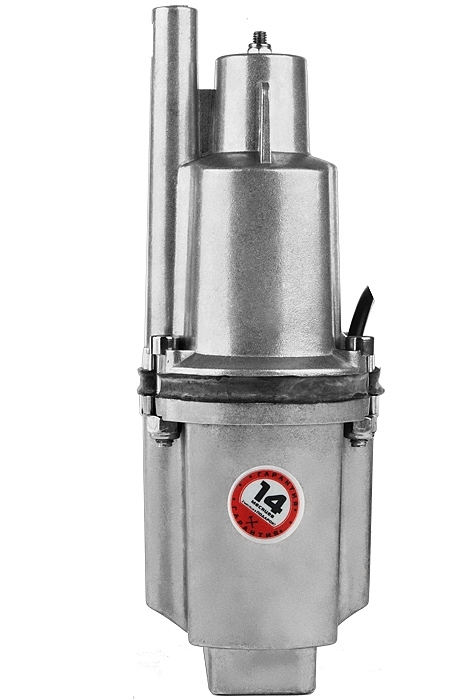 H \u003d (H 1 + H 2 + H 3) * 20%, Where
H \u003d (H 1 + H 2 + H 3) * 20%, Where
- H is the required pressure, m;
- H 1 - distance from the bottom of the source to the water table, m;
- H 2 - distance from the water table to the top of the source, m;
- H 3 - rated power of the pump (10-30 m).
The result obtained will be the indicator that is necessary for comfortable operation of the pump in your position. It is with a lack of pump power in the formation of pressure that boosting equipment is used.
As a rule, it increases the pressure in the system by 1.5-2 atm, and the head by 10-20 m.
The formula for determining this indicator is quite simple. You need to calculate the number of plumbing fixtures used and sum up the fluid flow rates.
P \u003d p 1 + p 2 + p 3 + ... + p n, Where
- P is the overall performance indicator;
- p n - water consumption from one device.
Thus, you will be able to find maximum amount liquid, which is necessary for the operation of the pipeline at maximum load. However, there is one caveat here.
A high pump capacity makes no sense if the source is unable to cover it. Therefore, always try to find out in advance the properties of your source, and then select the pump according to its performance.
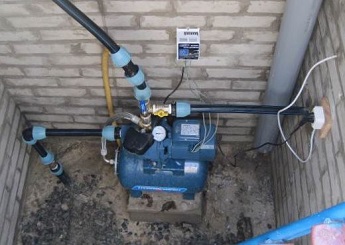 The price of booster pumps for plumbing or their analogues will also play a role. Still, the equipment is not cheap and not everyone will be able to afford it.
The price of booster pumps for plumbing or their analogues will also play a role. Still, the equipment is not cheap and not everyone will be able to afford it.
Connection Features
Connecting the pump to the water supply is not particularly difficult. You just need to take into account a few basic nuances and follow the instructions. The piping of the pump is done in such a way as to minimize the length of the pipeline.
The longer the suction pipe of the pump, the weaker the pressure will be at the outlet. This applies to pumping stations in the first place, since they have the lowest performance in their class.
Mounting features are as follows:
- Submersible pumps are installed directly into the water. They are connected to a water supply hose, an electric cable and a safety cable. Then the pump is carefully lowered into the well, where it is fixed at a certain level due to the presence of floats;
- Semi-submersible pumps are installed in the same way. There are differences here only in that when lowering the device, it is important not to wet its upper part;
- Connecting the pumping station to the water supply is also not overly complicated. It is even easier to work with it, since all the equipment is on the surface. You need to choose a place for the station, install it and connect it to electricity. The suction hose is lowered into a source of water and additionally fixed. It remains only to configure the automation and start the system;
- The booster pump for water supply is cut directly into the pipe. There may be several such pumps. For example, if one booster is not enough to fully power the entire plumbing system. This often happens in large houses with many floors. Installation consists in cutting off a piece of pipe and mounting a pump in its place. Advanced users can make a kind of pocket for circulation pump. To do this, tees are cut into the pipe, which form an additional mini-branch. All entrances are isolated shutoff valves. Now you can turn off or remove the pump at any time, without interrupting the functioning of the water supply even for a minute.
Every private house needs water for both domestic and household needs. Therefore, it is worth considering the arrangement of high-quality water supply. This is especially important in the suburban economy, if not central water supply. Also, such a system will help if the centralized water supply fails. It can be used as an auxiliary source of water supply. However, not only in country houses, but also in ordinary city apartments, there may be problems with water. The easiest way to handle this task is to purchase water pumps for home plumbing. Today, it is easy to purchase such a device. Manufacturers produce a wide variety of models for different purposes, different prices and power.
domestic water supply
All pumps for the home have many differences, which at first glance are not so easy to figure out. But in fact, there is nothing complicated about it. First you need to understand that such units are divided into 4 types:
Drainage.
Circular.
Vibrating.
Water-lifting.
The first type can be used to pump fluid from a basement or sewer. Circular are most often used in water supply and heating systems. The latter type is divided into two subspecies - superficial or submersible. Both of them are often used in summer cottages and cottages.
Each of the above types has its own specifications and features that make them different. Therefore, such equipment must be selected very carefully, paying attention not only to the cost, but also to the features. First of all, you should pay attention to such an indicator as productivity. This characteristic is especially important if such a unit is bought because of weak pressure in a private house. Let's consider each type in more detail.
Drainage and centrifugal pumps
Drainage pumps are most often used to pump water from the basement, pool. They are never used for pumping drinking water, they are only suitable for polluted water. The drainage has a good performance, but despite this it does not have a high head. The depth of its use does not exceed 7 meters, which is quite acceptable for installation in a private house.
Centrifugal pumps are the most common for domestic use. A rotating shaft with curved blades distills the liquid due to the pressure created inside such a device. Depending on the speed of rotation of the shaft and the size of the blades, the performance of this equipment also changes.
Vibrating and submersible
 The vibration pump for home heating and plumbing is powered by the mains, and due to the vibrator located next to the membrane, it is able to pump large volumes of liquid. For home plumbing, this type is used extremely rarely, as it creates noise. Most often it is used in well systems.
The vibration pump for home heating and plumbing is powered by the mains, and due to the vibrator located next to the membrane, it is able to pump large volumes of liquid. For home plumbing, this type is used extremely rarely, as it creates noise. Most often it is used in well systems.
As the name implies, submersible pumps are submerged in water, they are also called submersible. It is important for such pumps to ensure complete isolation of the electrical wiring of the system from water. This is the most powerful system, used mainly for wells, from which water is pumped into the home plumbing mechanism. household models of this type are designed to lift water from a depth of 10 meters. But there are also more powerful models, with diving to a depth of more than 100 m.
Surface pumps
Such pumps are installed on the surface near the water source. It can be placed on a container of water. They have simple design and low price. Used for pumping drinking water or for household needs.
If you equip it with a battery and control automation, then it is able to provide the house with an uninterrupted supply of water. It can be of different subspecies: centrifugal and vibration. Both types have already been described above.
Pumping stations
Such a system is most attractive for both suburban area as well as domestic plumbing. The main difference between pumping stations and other systems is a hydraulic accumulator, which accumulates and distributes water through all pipes. It is easy to install it in the basement and in any other utility room. This device provides full automation process of water supply and is able to work even in the event of a power outage.
Boosting pumps
This is another type of pump that is used if the home plumbing has multiple branches. Conventional pumps in this situation may not have enough power to push the liquid through the pipes. The principle of its operation is simple. The pump is equipped with a drive, which gives impetus to accelerate the pressure.
Installing the device is just as easy. To do this, it is necessary to embed it in the domestic pipeline, behind the collector, using fittings.
When purchasing a pump, there are several important parameters to consider:
Purpose of use.
Required performance.
Required pressure.
Having decided on such indicators, it will not be difficult to choose a pump suitable for home plumbing.
A good water pump is an indispensable thing for organizing water supply, heating and sewerage at home and in the country. With its help, the uninterrupted operation of all the listed systems is ensured, as well as irrigation and watering of the summer cottage (garden, lawn, etc.)
All pumping devices (namely, they can be attributed to), regardless of type, model and configuration, have a single device principle: as soon as the electric motor is turned on, a vacuum chamber is formed inside the pump. In her under the influence low pressure water is sucked in and begins its movement to the outlet pipe. And already through the pipe with a strong jet enters the water supply or hose.
Pressure in pumping system is determined by the force of water extrusion, and such extrusion must be sufficient in terms of pressure to overcome the hydraulic resistance.
As for the actual pumping structures, they differ significantly. And first of all, according to the method of creating a vacuum inside the case. They can be divided into:
- centrifugal;
- vibration (electromagnetic);
- and vortex.
More household pumps differ in their location relative to the water tank. There are surface models and there are submersible models.
Overview of modern pumping designs
In order for the water pump to function efficiently, it is important to choose the right model and type of device. Because if there is not enough power or the design is not suitable for the tasks, operational failures cannot be avoided. You will either have to buy a new pump, or buy more additional elements. And this is fraught with serious financial costs, which is called "wasted."
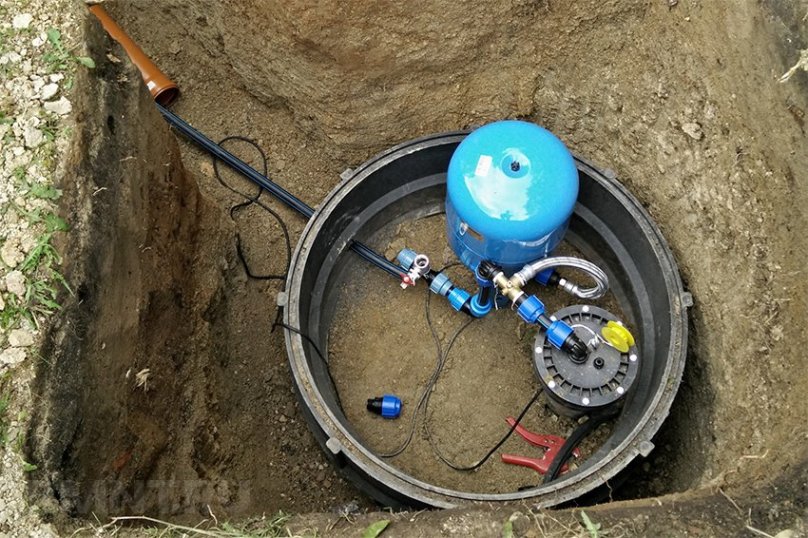
Installing a pump on a well
By design and functionality, all pumping devices are divided into:
- borehole, well (submersible and deep);
- circulation;
- water-lifting (submersible and surface);
- drainage;
- and motor pumps.
Borehole and well water pumps for home plumbing provide uninterrupted water supply for individual supply systems in a country house or in the country. Circulation devices are designed for forced water circulation not only in water supply systems, but also in heating and air conditioning systems. The water-lifting type of pumps is used to extract the water mass from various sources. A drainage devices pump out contaminated liquid from sewers, basements, wells.
Household pumps: characteristics
Any water pump has a set of individual technical and operational characteristics:
- Surface pumps. Their scope is limited to increasing system pressure, as well as providing cold water supply. In addition, these models are actively used to extinguish fires. This type of equipment is divided into:
- vortex electrical devices;
- and centrifugal.
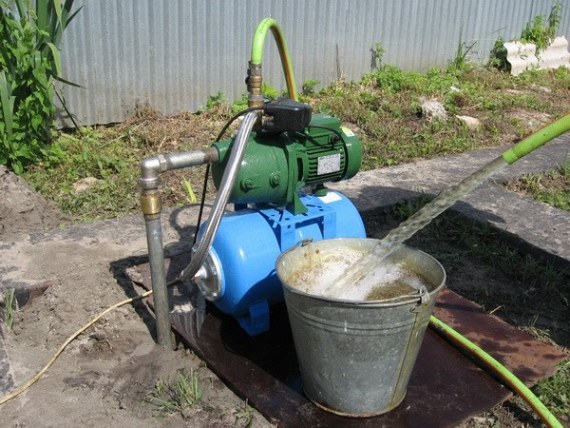
Centrifugal pumps are needed when it is necessary to pump out water from shallow reservoirs: wells, wells. The suction depth of such equipment does not exceed 6 m. If you need to raise liquid from a more serious depth (up to 10 m), use devices equipped with an ejector. These are very noisy during operation, so they are more suitable for installation in technical rooms. Lightweight models of such units are easily installed directly on the water surface using foam rafts.
The suction depth is also limited for vortex pumps. Therefore, they are traditionally used to increase pressure in plumbing and heating systems Oh.
- Deep pumps. If surface pumping devices cannot cope with large-scale depth, submersible electrical units are purchased. Such deep devices are placed directly into the source, so the casings of these pumps are made of materials that are not subject to corrosion. In some models of the case, as well as working structural elements are made of stainless steel.
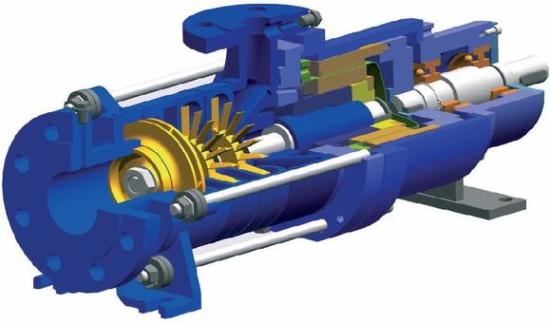
0Submersible electric pumps are designed in such a way that their motor is cooled by the liquid passing through the device. There are original models that are installed on lakes and small rivers for water intake by the horizontal method.
- Circulating pumps used to move fluid through pipes of heating systems. Such household water devices enable system adjustment, and also allow significant savings in energy consumption.
Many circulating pump designs regulate the speed of the shaft. This makes it possible to reduce noise and at the same time increase the operational life of the device with a clear reduction in energy consumption.
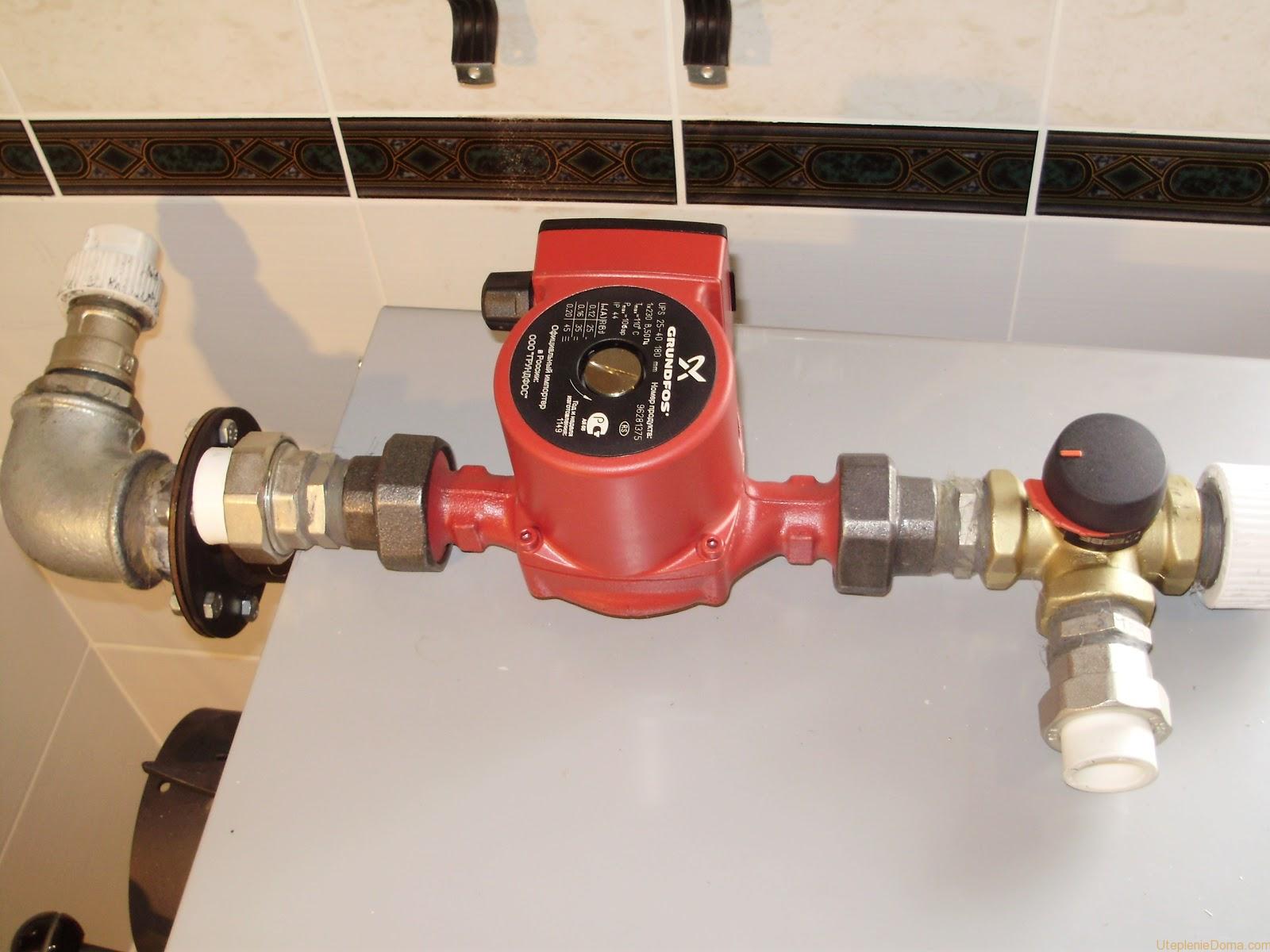
Attention ! If you need to choose a unit with a forced circulation principle of operation, you should stop at a model with a reduced noise level and guarantees of durability. In addition, the level of energy consumption is considered an important parameter.
If the choice was made correctly, the circulation device will work without problems. Although, of course, much depends on how competently and professionally such or country house. First of all, installers will need to make sure that in vacuum system there is no air. It is possible to eliminate possible air bubbles with the help of special automatic air vents.
- Pumps are vacuum drainage. Compact and mobile, such units serve for a long time. These models are equipped with floats that turn off the device if there is no water. Exactly the same principle operates and special "fecal" vacuum pumps pumping wastewater in modern sewer systems.
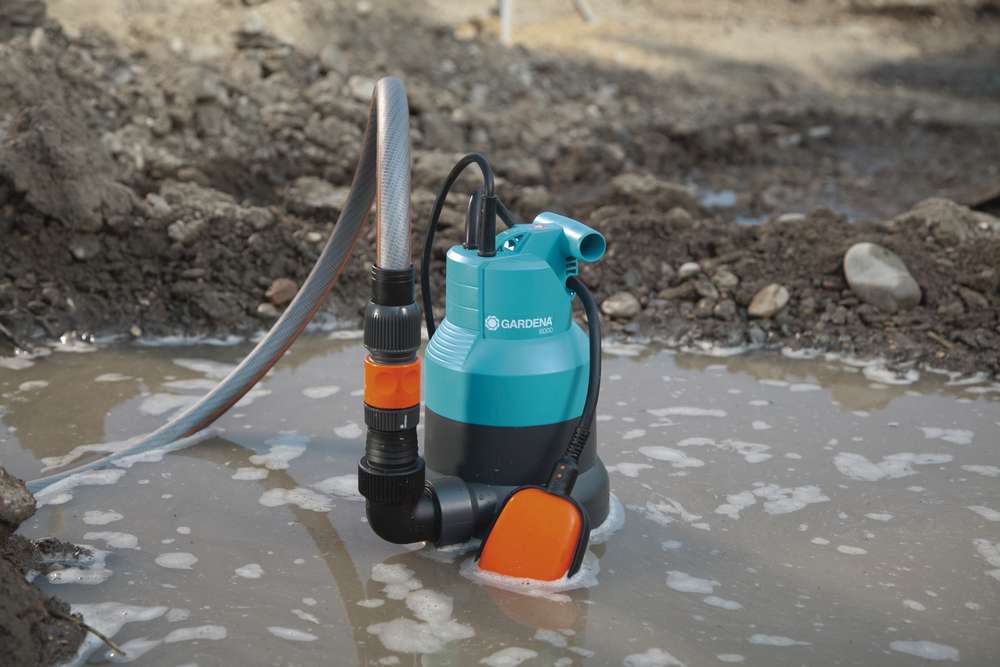
Attention ! Unlike circular, drainage structures are easy to install. They can be mounted independently, even without experience in such work, but guided only by the instructions. You only need to additionally purchase a pressure gauge, hoses, a special filter.
The principle of choosing a domestic pump
To choose the right water pump, you should be guided by the requirements that accompany the task.
Do you need equipment to extract water from a source? You need to buy a water pump. Is forced system fluid circulation required? It is necessary to purchase a circulation device. Want to pump out dirty waste fluid? Need a drainage vacuum design.
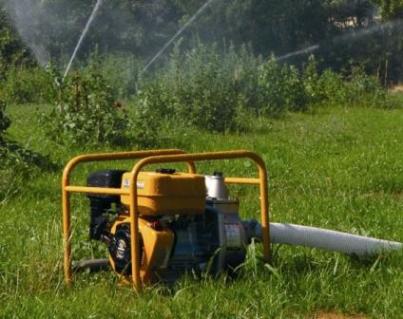
Motor pump at the dacha
It is also necessary to evaluate the water head and performance of the model. These parameters speak of pumping efficiency. And here it is already possible to judge: is such a volume of water mass pumped over a control time period required?
Both the performance of the device and the pressure are directly dependent on the pressure provided by a particular model. As for the definition of the most important control characteristics, then you need to focus on:
- the size of the site intended for installation;
- groundwater quality;
- specific household needs, etc.
On a note ! It should be noted that any electric pump works from the network, which means that it can only be installed where this vacuum device will be provided with access to electricity.
No less important is such an indicator as plumbing parameters. It is he who allows you to accurately calculate the effectiveness of home or dacha system water supply. here it is important to know the diameter and length of the water pipe, the material of its manufacture, as well as the composition of the fitting kit.
The pumps for water supply, the features of their choice and the principle of operation are described. The well pump and the pump for wells are considered in detail, their differences between themselves and the scope of application are listed. The advantages and characteristics of the pumping station are considered.
Figure 1: Water supply pump
Advice! If the distance to the water surface is small, then the simplest and most convenient method of lifting it is self-priming pumps.
Self-priming pump
There are several types of self-priming pump. Some have a built-in ejector and, thanks to the vacuum, provide the rise of water. Ejector pumps for the water supply of a private house are very noisy and therefore they are usually installed outside the building, in a special room. These pumps are also very handy for watering gardens and gardens, or for filling ponds and pools. In other self-priming pumps, there is no ejector, and water can be sucked in, since there is a special multi-stage design of the hydraulic part. Such a pump works virtually silently.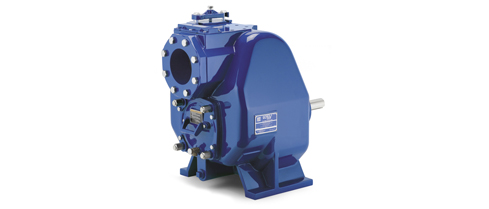
Figure 2: Self-priming centrifugal pump
During the water supply of buildings, some methods of application are possible self-priming pumps. First of all, if the house has storage tank, then to use the shower or wash the dishes it must be filled with water. The main thing is to install a sensor in the tank that will monitor the degree of water and turn off the pump so that the tank does not overflow. Such a sensor gives the pump signals to turn on if the liquid in the tank is less than necessary. This system has some disadvantages. (See also: )
System Disadvantages
- low water pressure;
- tank space required
- you need to carefully monitor the automation, which is responsible for turning off the pumps when the tank overflows. But if this system fails, then your house may be flooded with water. Usually, in order to prevent flooding of the house, the tank is equipped with an overflow pipe that drains emergency excess water from the house.
Features of the pump
A self-priming pump for home water supply, which is installed on a membrane tank and has a pressure switch, is called a pumping station. The membrane tank is a sealed metal vessel, divided into several parts by a special membrane. One half of the tank is filled with air under pressure, and the pump pumps water into the other half. The relay sets a huge pressure limit to which the air in the tank can be compressed. When will be reached set pressure the pump will turn off. (See also: )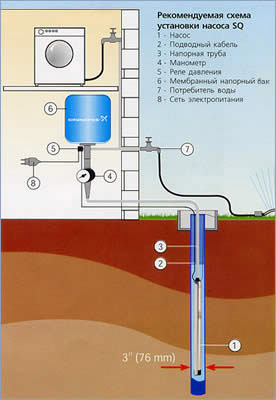
Figure 3: Pump Installation Diagram
Thus, you can use the water accumulated in the membrane tank. If the water flow is small, then the pumps will not turn on every time. And only when the pressure drops to the lower limit set on the relay, the pump will turn on again. The use of self-priming pumps has advantages.
- There is pressure in the water supply system, with the help of which many water heaters work;
- Switching on and off of the pump is reduced, and thus its service life is extended;
- Thanks to membrane tank reserves of several tens of liters of water are created, and if the electricity is turned off, then you can use this water without obstacles; (See also: )
- There is no need to install a storage tank in the attic of the building.
Advantages of a pumping station
The pumping station is quite compact, lightweight and mobile. The mass of almost each pumping station is about 30 kg, so one person can easily carry it. During the installation of this station, it must be borne in mind that on the hose that goes down into the well, it is imperative to install check valve to prevent water from "leaving" the system back into the well when the pump is turned off.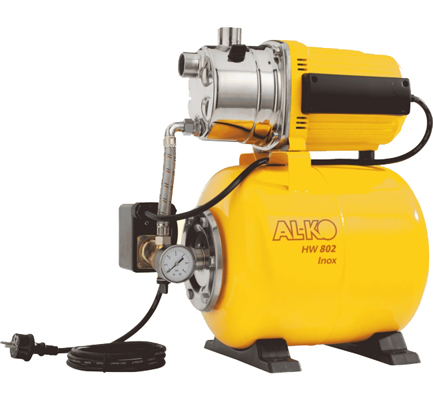
Figure 4: Pump station
The most important parameter characterizing pumping stations is their nominal flow, which is measured in cubic meters per hour. This indicator indicates how much water you can get in a certain time using this station. Many models on the market have a huge flow, approximately 3-8 cubic meters per hour and a pressure with which water rises to a height of up to 60 m. (See also:)
As already noted, the pumping station can be located not only in the house, but also outside it. In the event that you do not know how to choose a pump for water supply, you need to seek help from a specialist who, at a glance at your well or well, will determine what pump parameters are required. After acquiring the necessary equipment, you only need to connect the pump to electrical network, then lower the hose into the well and connect the pressure pipe to the water supply.
Advice! If you want this station to be able to work constantly, you will need a fairly serious preparatory work. The pumping station must be installed in a warm building, and be sure to insulate the pipe from the well to the dwelling or lay it in the ground below the freezing level.
In order for the water not to freeze in the hose, the well must also be insulated. If in the area where your Vacation home, the water level is below 8 meters or the water quality is not suitable, then in any situation an ordinary pumping station will not be able to help you and some other option will need to be considered. In this case, submersible well or well pumps can be used.
Downhole pump
Compared with pumping station, choosing, installing and connecting a borehole pump for hot water is much more difficult. Yes, and the cost of high-quality Western European well pump several times higher. And this is not taking into account the cost of installation and drilling. The high prices of this type of pump are due to the fact that, with its relatively small diameter, it must provide a high pressure. To solve such a difficult task, designers use rather complex technical solutions, for example, they create multi-stage suction systems, which makes the device more expensive.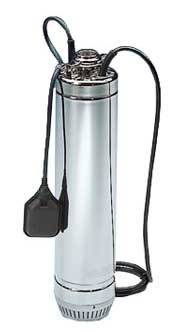
Figure 5: Submersible well pump
well pumps
Well pumps differ from well pumps in that they have an internal engine cooling jacket. It is because of this that they can be placed in a well or well of a huge diameter. The pump of both types has the shape of a cylinder, however, the well has large diameter, and therefore makes better use of the engine's capability. Such pumps have increased performance and lower cost during the same power consumption and head as the borehole pump.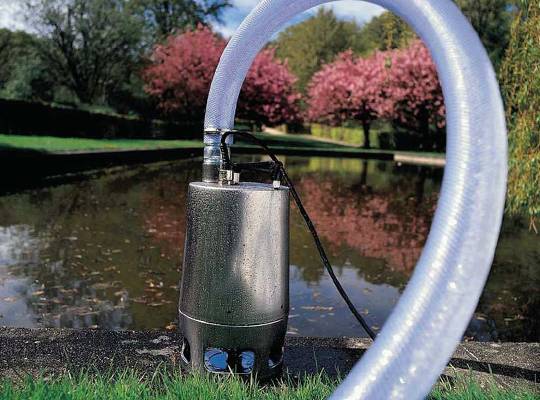
Figure 6: Well pump
It should be noted that, unlike well pumps, the electric motor of well pumps is cooled by rising water flows. For this reason, for any downhole pump in the technical documents, it is imperative to indicate the minimum allowable speed of water movement. Therefore, during the use of a borehole pump, the diameter of the well is so important, which should not be much larger diameter pump.
The use of materials is allowed only if there is an indexed link to the page with the material.
Water is considered to be the main natural resource. Despite the fact that the age of advanced technologies is now outside the window, not everywhere it is possible to use central water supply. The optimal solution in this situation is autonomous water supply using a pump. Water pumps for domestic plumbing transport water under pressure.
To date, on domestic market presented different kinds water pumps, differing not only in production and operational capabilities (power is especially important), but also in the price range.
It is quite difficult for an ordinary consumer, inexperienced in this matter, to make right choice due to the huge variety of modifications. Special demand and popularity water pump used by the owners of summer cottages, suburban areas or owners of private houses. Using the pump, it is possible to pump water from reservoirs nearby to the site for economic and domestic needs. This device helps to effectively solve the problem of watering the garden, while saving time and physical forces person.
Huge variety existing models, can be conditionally divided into 2 main categories:
- household (used on their own sites);
- professional (used on an industrial scale in production).
When buying a water pump for the home, it must be remembered that the functionality and productivity of the purchased equipment must correspond to the working conditions and tasks.
Based on parameters such as operating conditions and location relative to the water source, the pump can be:
- submersible;
- surface.
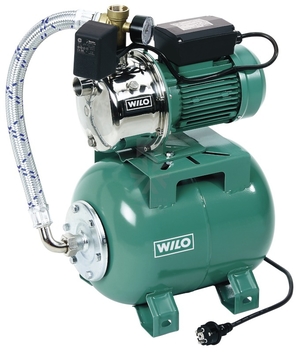 At the core productive activity pumping devices, regardless of their modification, the general principle is used. During operation, a vacuum is created, as a result of which the liquid is sucked into the vacuum chamber and under high pressure is pushed out of the tank into the pipeline, heading to the end user. The force with which the liquid will come out depends on how much pressure is present in the central system. Its indicator must be high enough so that the water can easily overcome the hydraulic resistance.
At the core productive activity pumping devices, regardless of their modification, the general principle is used. During operation, a vacuum is created, as a result of which the liquid is sucked into the vacuum chamber and under high pressure is pushed out of the tank into the pipeline, heading to the end user. The force with which the liquid will come out depends on how much pressure is present in the central system. Its indicator must be high enough so that the water can easily overcome the hydraulic resistance.
Structurally, water supply devices can differ significantly from each other, depending on which mechanism is used to create pressure in the device, the device for pumping liquid is made in the following variations:
- centrifugal;
- vortex;
- vibration.
Each of the above types has its own advantages and disadvantages.
Centrifugal equipment
The centrifugal water pump is actively used both at the household level and for industrial water supply. Functioning is carried out due to the creation of centrifugal force inside the apparatus, under the influence of which the liquid begins to move. The power plant, rotating the blades and wheels, first draws in water, and then pushes it through the outlet into the central line.
Use in the manufacture of pumps quality materials, guarantees the final product excellent operational capabilities, reliability, practicality and high performance. Such centrifugal equipment can work continuously for a long time. Special engineering solutions are implemented in their design, so the equipment can be safely used in the most aggressive climatic conditions.
The indisputable advantages include ease of maintenance, affordable price range and a good coefficient useful action. However, in addition to the positive aspects, it is also necessary to note the disadvantages that are inherent in centrifugal devices.
The following deserve special attention:
- air entering the pipe stops the pump;
- voltage drops affect the continuous and stable operation of the device;
- Before each start-up of the pump, its body must first be filled with water.
Attention, only TODAY!








